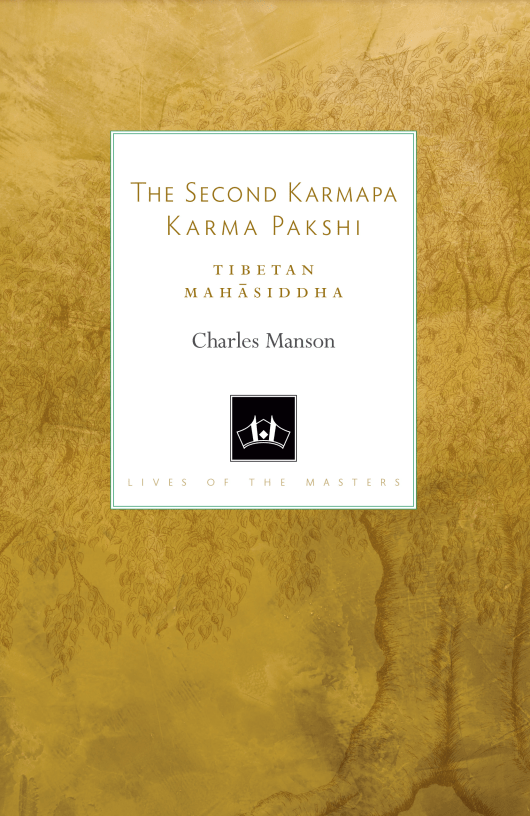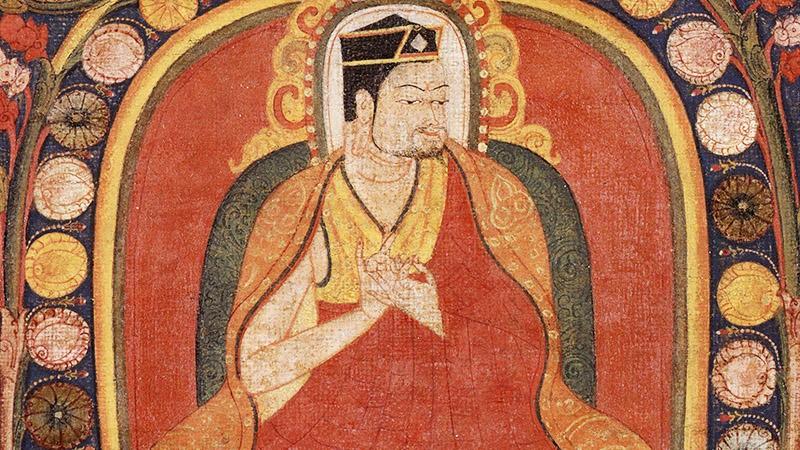The Karmapa is one of the most distinguished lineages in Vajrayana Buddhism. Its title was first held by a charismatic and powerful figure, Karma Pakshi (1204–83), whose life and legacy forms the focus of Shambhala Publications’ new book in the “Lives of the Masters” series. The Second Karmapa Karma Pakshi: Tibetan Mahasiddha (Shambhala Publications 2022) is the most recent addition to the corpus of books about Karma Pakshi’s life. The author is Charles Manson, cataloguer for the Tibetan Collections at the British Library and the Bodleian Library (Oxford University). Here, Manson deploys intricate history and masterful storytelling to present a vivid picture of Karma Pakshi that is at once detailed and accessible.
Karma Pakshi is a worthy addition to Shambhala’s line-up of illustrious Buddhist historical figures, because he is counted as the first holder of the Karmapa title in his ecclesiastical lineage. The Karmapa lineage is extremely influential, but at a very basic level, each Karmapa serves as the head of the Kamtsang branch of the Kagyu school. Indirectly, the Karmapa influenced the eventual dominant tradition of selecting reincarnated lineages for Tibetan centers of power, most famously that of the Gelugpa school, which chooses each reborn successor in the Dalai Lama lineage. As Manson notes in his introduction:
The ecclesiastical succession by rebirth system that permeated official positions in Tibet, and indeed farther afield in Central Asia, was dominant for more than three hundred years. The initial developments of the tradition are often credited to Karma Pakshi’s example in the thirteenth century.
(Manson, 8)
Karma Pakshi also experienced his fair share of drama, encountering Mongke Khan and Kublai Khan at their courts, before eventually suffering imprisonment, torture, and exile at the hands of Kublai for daring to leave.
The book is straightforwardly divided into two broad portions: Part One: Life and Legacy, and Part Two: Writings. From the outset, Manson situates the reader in the broader historical context: the international upheavals across Asia in the 13th Century, Karma Pakshi’s life and relationship to two supreme khans, and his legacy. This biographical portion of the book is an excellently told story. Then, Manson examines in his second part Karma Pakshi’s various writings, which betray the personality of a rich and lively thinker who traveled widely, met many people and garnered widespread devotion, and had a wide range of religious interests. His compositions are important sources for a glimpse into the thought of a powerful ecclesiastic innovator and leader in medieval Tibet.
As Manson is at pains to emphasize, Karma Pakshi’s idea of reincarnation reinforced the institutional continuity of his seats of power—in particular the leadership of Tsurpu—while bolstering the transmission of lineage. He achieved this in his memoirs by continuously self-identifying with the saintly Düsum Khyenpa, (Manson, 119) which gave rise to the tradition that a reincarnated Karmapa would recognize names, objects, and people from his previous life. Manson notes that when he was young, Karma Pakshi was told that he had a “close connection” to Dusum Khyenpa, and it was only after Karma Pakshi became known as “Karmapa” that the title was posthumously extended to his “predecessor.” (Manson, 131) In his memoirs, Karma Pakshi obliquely indicated the mother of his birth successor, and his lieutenant, Lama Nyenre Gendun Bum, closely ensured the continuity of the transmission.
Therefore, without question, his core legacy is being seen as “a figurehead for the catenate reincarnation tradition for Tibetan ecclesiastics. The full institutionalization of the nascent tradition took some further lifetimes to fully develop, yet, once it had developed, the meme of reincarnate ecclesiastics spread far and wide.” (Manson, 128) Karma Pakshi became well known for two deity practices: Gyelwa Gyatso deity sadhana (also known as Red Chenrezik) and the Mahakala protector rite. (Manson, 121) He also inspired several terma practices while also passing down his own terma.
Yet considering his eminence in the Karmapa lineage, his writings are not well known or often quoted. (Manson, 127–28)
We turn now to some of these compositions, which contain, as alluded to above, memoirs meditating on the nature of reincarnation and his connection to Dusum Khyenpa. Karma Pakshi also seemed keen to discuss theory on a practice called “the three kayas,”although he more often used the term “four kayas” and even “five kayas.” This meditation practice and doctrine was his “main interest during his preaching itineraries, the journeys from Central Tibet to Karakorum to Almaliq to Xanadu and back to Tsurpu, lasting more than 15 years.” (Manson, 153) He also recorded an encounter with the bodhisattva Manjushri:
When I, Karma Pakshi, had been banished to the banks of the lake by the town of Ke’u Je’u in China and then summoned back, there occurred the blessing of Ārya Mañjuśrī, along with many miracles, and we actually met. During this period, I wrote about valid cognition and debate in the Twenty-One Questions and Answers. Due to the blessing of the Mañjuśrī wisdom-being and the complete glory of his great knowledge, I perfected the naturally arising wisdom that has no lack whatsoever of knowledge or realization about all phenomena of samsara and nirvana. I was spoken of as Omniscient Rangjung Dorjé.
(Manson, 189)
Finally, Karma Pakshi left behind a series of recollections in his memoirs about his life. They are a mix of factual events with discussions on doctrine, along with tales of visions and religious experiences. He even dabbled in prose narrative, which can be found in a section of his memoirs titled Account of the Erection of Great Deity Ornament of the World. In this story, Karma Pakshi dreams of riding a magical horse during his trip to Kucha or Turpan along the Northern Silk Route, (Manson, 185) and had a vision of Palden Lhamo. (Manson, 188) His other writings include musings on consecration and tantra, a deathbed song, a song dedicated to a student, and an esoteric great treasury text.
While The Second Karmapa Karma Pakshi is presented as an introduction, its attention to detail and analyses of events in his life is quite meticulous and impressive. But perhaps it is the author’s second section, on Karma Pakshi’s writings, that adds more shades of complexity to this famous figure, who undoubtedly possessed compelling charisma and conviction that he was not afraid to leverage for what he saw, surely, as righteous causes. These include his journey across Asia, his courting of two khans, and an ambitious consolidation of his lineage, which his disciples managed to keep within his family for a couple of centuries while extending its political influence for the next 800 years. Without these seemingly distant foundations laid back in the 13th century, it is doubtful that the Karmapa, and indeed other lineages of reincarnation, would be as famous globally as they are today.
References
Manson, Charles. 2022. The Second Karmapa Karma Pakshi: Tibetan Mahasiddha. Boulder, CO: Shambhala Publications
Related features from BDG
Book Review: Xuanzang: China’s Legendary Pilgrim and Translator















